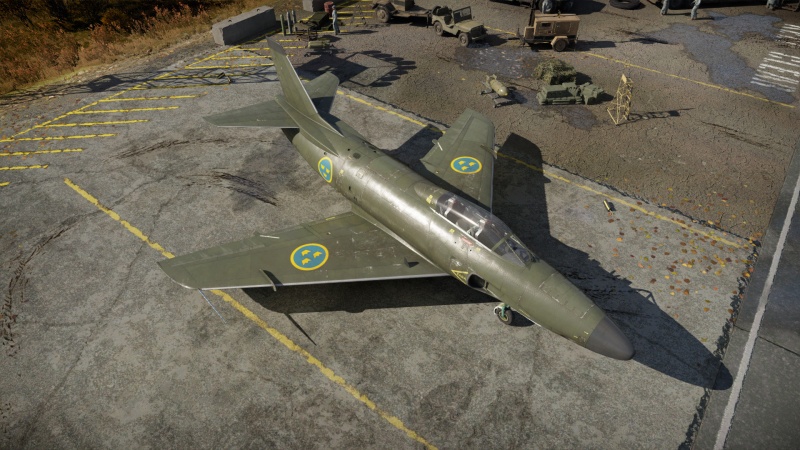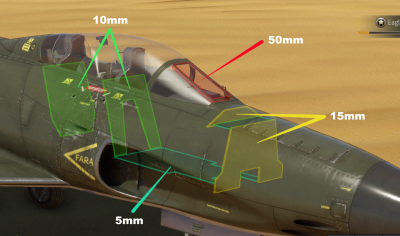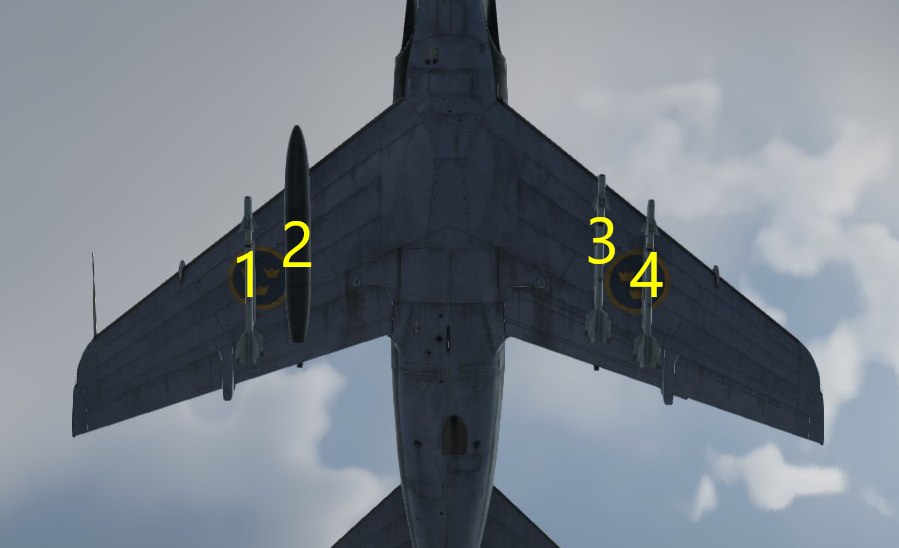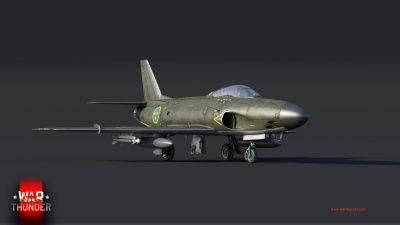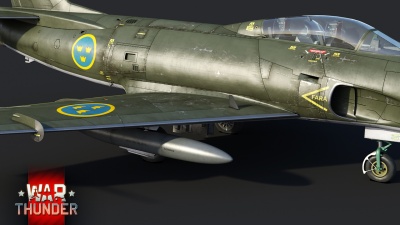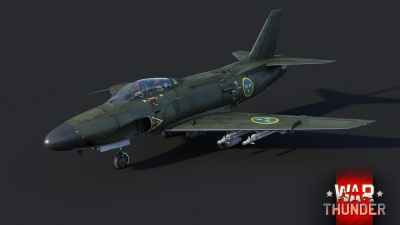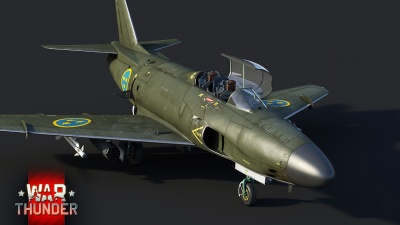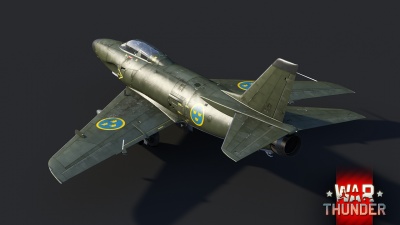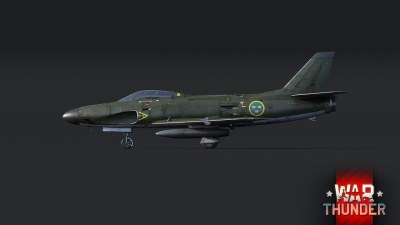J32B
Contents
Description
The J32B Lansen was an all-weather fighter/interceptor which entered service with the Swedish Air Force in 1958. 118 aircraft were built, with 26 involved in accidents. Compared to the previous A32A, the J32B comes with a more powerful RM6A engine and four 30 mm Akan m/55, as well as the ability to carry air-to-air missiles. The J32B retired in the 1970s and was replaced by the J35.
The J32B was introduced in Update 1.95 "Northern Wind". The J32B combines excellent climb rate and devastating firepower, both in terms of suspended and offensive armaments. The J32B can easily get to an altitude where it can look down on opponents and go into a dive to deliver a lethal bite from its devastating firepower, then using the energy it got from the dive to make a quick escape and gain altitude again. Using the afterburner will get it out from dangerous situation if needed, though will come at a cost of the fuel consumption will rise and drain the fuel tank fast.
General info
Flight performance
The Saab J32B Lansen is a powerful interceptor built for all-weather operations. Being the descendant of the earlier A32A, this version focuses on air-to-air combat instead of its previous role as an air-to-ground platform. To achieve this, the J32B received the new RM6A engine. This engine is a Swedish license-produced variant of the Avon 300, producing a staggering 6,810 kgf when engaged with full afterburner. This engine was originally developed for the Lightning F.6. This makes the J32B a subsonic plane with a supersonic engine, resulting in incredible acceleration and energy retention. Staying fast and avoiding dogfights is the main advantage of the J32B, as the airframe is relatively large and cumbersome, not really meant for aerial manoeuvres. However, a single pass is more than enough thanks to four centre-mounted Akan m/55 cannons, with a incredible 24 kg burst mass. The J32B is also outfitted with four RB24 air-to-air missiles capable of killing enemies far beyond the plane's reach. This, combined with the incredible thrust, lets the J32B decide when, and how to strike down opponents; a luxury most planes can only dream of.
| Characteristics | Max Speed (km/h at 0 m - sea level) |
Max altitude (metres) |
Turn time (seconds) |
Rate of climb (metres/second) |
Take-off run (metres) | |||
|---|---|---|---|---|---|---|---|---|
| AB | RB | AB | RB | AB | RB | |||
| Stock | 1,133 | 1,128 | 34.4 | 34.6 | 84.5 | 78.4 | 900 | |
| Upgraded | 1,148 | 1,140 | 33.6 | 34.0 | 119.6 | 101.0 | ||
Details
| Features | |||||
|---|---|---|---|---|---|
| Combat flaps | Take-off flaps | Landing flaps | Air brakes | Arrestor gear | Drogue chute |
| ✓ | ✓ | ✓ | ✓ | X | X |
| Limits | ||||||
|---|---|---|---|---|---|---|
| Wings (km/h) | Gear (km/h) | Flaps (km/h) | Max Static G | |||
| Combat | Take-off | Landing | + | - | ||
| 524 | 491 | 320 | ~11 | ~5 | ||
| Optimal velocities (km/h) | |||
|---|---|---|---|
| Ailerons | Rudder | Elevators | Radiator |
| < 850 | < 650 | < 600 | N/A |
Engine performance
| Engine | Aircraft mass | ||||||
|---|---|---|---|---|---|---|---|
| Engine name | Number | Basic mass | Wing loading (full fuel) | ||||
| Svenska Flygmotor RM6A | 1 | 8,882 kg | 312 kg/m2 | ||||
| Engine characteristics | Mass with fuel (no weapons load) | Max Takeoff Weight | |||||
| Weight (each) | Type | 9m fuel | 20m fuel | 30m fuel | 32m fuel | ||
| 1,400 kg | Afterburning axial-flow turbojet | 9,711 kg | 10,602 kg | 11,462 kg | 11,644 kg | 13,500 kg | |
| Maximum engine thrust @ 0 m (RB/SB) | Thrust to weight ratio @ 0 m (WEP) | ||||||
| Condition | 100% | WEP | 9m fuel | 20m fuel | 30m fuel | 32m fuel | MTOW |
| Stationary | 4,727 kgf | 6,807 kgf | 0.70 | 0.64 | 0.59 | 0.58 | 0.50 |
| Optimal | 4,727 kgf (0 km/h) |
7,212 kgf (1,160 km/h) |
0.74 | 0.68 | 0.63 | 0.62 | 0.53 |
Survivability and armour
- 5 mm steel plate - cockpit floor and spacer plate between frontal armour.
- 10 mm steel plate - behind the pilot and GIB's seats
- 15 mm steel plate - armour plates in front of the cockpit section
- 50 mm bulletproof glass - armoured canopy windscreen
The J32B features good pilot protection. A 50 mm bulletproof screen, and plates surrounding the two pilots, reaching thickness levels of between 5 to 15 mm. These plates were originally meant to save the pilot from incoming ground-fire due to its earlier ground-attack purpose. Thanks to this excellent protection, as well as having two pilots instead of one, dying by a pilot knockout is highly unlikely in comparison to other fighters of the same rank. The J32B is also survivable in terms of fuselage strength. A single pass rarely knocks it out immediately, and seems more on-par with the Vautour IIA than other fighters at its rank. This strength can be attributed to the separated fuel-tanks, as well as the short engine (in relation to the fuselage). This high survivability makes the J32B quite forgiving for making mistakes, as it usually isn't hard to return back to base for repairs. It is important, however, to avoid all damage possible, as even the slightest fuselage damage can heavily cripple the J32B's general flight performance. A badly damaged fuselage makes the J32B unable to retain energy, keeping it away from its main advantage. The J32B is also prone to catching fire. Although the fire is easily put out, the damage suffered is usually more than fatal.
Modifications and economy
Armaments
Offensive armament
The J32B is armed with:
- 4 x 30 mm Akan m/55 cannons, nose-mounted (90 rpg = 360 total)
The J32B is outfitted with four nose-mounted Akan m/55, which are Swedish-made versions of the popular ADEN cannon, found on British aircraft. Although sharing a similar mounting to the Hunter F.6, the Lansen fires almost 4 kg of extra burst mass, as the Swedish guns have a higher fire-rate. High burst-mass is generally a good thing, as it compensates for sloppier manoeuvres, where the plane gets less time on target. The J32B doesn't really benefit from this upside, however, as the ammunition count is only 90 per gun, rounding the total up to a mere 360. This is almost half of what the Hunter offers, while still having a higher fire-rate. This forces the J32B to be played with incredible trigger-patience, as any unnecessary moment of fire can cost half the magazine, highly limiting its match potential. This is hampered even further by the fact that none of the rounds in the belt have tracers, leading to an inability to accurately hit the target. This can be compensated for by equipping air-to-air missiles, which sacrifices a bit of mobility for the option to save ammunition.
Suspended armament
The J32B can be outfitted with the following ordnance:
| 1 | 2 | 3 | 4 | ||
|---|---|---|---|---|---|
| srak m/57B rockets | 19 | 19 | |||
| RB24 missiles | 1 | 1 | 1 | 1 |
| Default weapon presets | |
|---|---|
| |
Usage in battles
Basics
Being an interceptor by nature, staying fast remains a priority above anything else. In order to achieve this, the J32B likes to avoid strong aerial manoeuvres by keeping altitude and utilizing boom & zoom tactics. For a new pilot, especially one coming from the J29D or J29F, the luxury of an afterburner shouldn't be much of a surprise. The J32B keeps speed much better than the afterburning Tunnan, while still offering high firepower and vertical energy to boot. This compensates for the sluggish performance the plane shows in aerial combat. A newer pilot should stick to altitude, as the higher areas of the map are sometimes inaccessible by other enemies. It's still important to locate enemies with the same strengths as the J32B. These include the Hunter FGA.9, F-100A, Shenyang F-5, and the F3H-2, among many others. These, along with all other missile-carrying fighters, will make flying the J32B a pilots nightmare. The subsonic fighters at lower battle ratings are easy to fend off, requiring mostly speed and slight banking manoeuvres. But the planes placed between 9.0-9.7 pose as a strong counter to the J32B, as they force it to manoeuvre. Do not fly straight when enemies attack you from behind. Flying straight ensures that anyone behind you has a chance to shoot you down. Even if the J32B handles like a bus, it's always worth trying to avoid any damage possible, as it will only lower your chances of survival.
Landing
One of the larger difficulties with the J32B is landing. The J32B is very good at staying fast, even without engine thrust. With a slow turn-rate, slowing down becomes even harder. Although the airbrake on the J32B isn't very large in comparison to other transonic fighters, it does still work, giving the plane some extra deceleration. When below ~500 km/h, the J32B can deploy its Fowler-design flaps, which cause intense drag, slowing the plane down to much more manageable speeds. The landing approach should be done at around 300 km/h to prevent landing flaps from ripping. This speed should be higher if the plane is out of fuel, as staying at 300 km/h has to be done with the help of some engine throttle. If the J32B approaches below 300 km/h without an engine, the plane won't be able to nose up before touchdown, due to the bad stall-speed of around 200 km/h. When the J32B has finally touched the landing strip, it's important to keep holding brakes, as the J32B needs as much runway as possible. If the J32B is approaching the end of the runway, the J32B can emergency drift by using full rudder below 100 km/h. Although this may result in a broken wing, it's usually better than overshooting the landing strip.
Aggressive playstyle
A J32B pilot comfortable with trigger patience, aerial manoeuvrability, and central awareness can slowly attempt to push the J32B to its limits. The J32B, especially when spaded, shows incredible and almost unmatched energy retention even at higher tiers. Combined with a weak turn radius and strong acceleration, the J32B can easily throw itself into any engagement, choosing to disengage whenever it pleases. This mentality can be further enhanced by making the aircraft as light as possible, taking only 20 minutes of fuel, and sometimes disregarding suspended armaments entirely. With spaded performance and minimal weight, the J32B will stay above 1,100 km/h no matter the aerial manoeuvre, giving it the ability to escape no matter what's behind it. This also mitigates the sidewinder issue the J32B suffers from. When the J32B has the ability to continuously turn without losing speed, nobody will have the ability to achieve a perfect lock-on state. A J32B pilot still needs to be aware of incoming gunfire since cutting this turn can be easily achieved. This can be easily improved on by shifting direction every once in a while, making the chasing opponent lose speed in the process. When combined with some training, The J32B turns into a unbeatable defensive flyer compared to the usual cannon-fodder experience. It is worth noting that this playstyle is incredibly challenging for inexperienced J32B pilots, as it requires incredible trigger patience and G-load awareness. Anyone looking to play this aggressive approach can always go for less drastic changes, by still taking suspended armaments, or only focusing slow opponents.
Dealing with Supersonic Aircraft
As the J32B sits at the very edge of the transonic era, it's no surprise the vehicle faces off opponents far more advanced and powerful. When the J32B is the fastest plane in a match, it's quite common to play passively and safe, as nobody has the ability to reach it. But as the J32B goes head-to-head with an F-4E, the Lansen stands no chance of getting away. The general goal becomes to avoid cannon fire and incoming missiles, which can be best achieved by staying low on the deck, cruising at maximum speed. If engaged with an enemy, the J32B should go back to the primary objective of retaining speed and energy while still pulling as hard as possible. The playstyle doesn't change a lot from the aggressive one, as the Rb24 missiles become even more dead weight than before, and lasting longer than 20 minutes is more of an miracle than a expectation. One overlooked detail is how the J32B now turns better in comparison, as fully loaded Phantom and MiG-21s struggle to keep with it. Heavy F-4EJ's need to dump tons of speed to even marginally cut the turning radius of the J32B. This can be exploited by a veteran pilot, as this opens up opportunities to energy-trap and finish off the cumbersome phantom. the more lightweight deltas such as the MiG-21 and Mirage meet different fates, as they easily cut the turn from the start, forcing the J32B to manoeuvre. However, as the J32B doesn't lose energy compared to the aggressor, it can easily keep turning until the enemy runs out of speed to follow up with, allowing the J32B to swoop in for a finishing blow.
Some small advice would be to avoid other transonic/slower supersonic planes, as they will gravitate to using the same tactic as the J32B, but with greater success. Planes like the MiG-19S, MiG-19PT, and the Q-5 all excel at retaining speed like the Lansen, making it impossible to shake them off. If the J32B comes across a dire situation where several opponents are behind it, it's important to keep turning no matter what! Opponents behind the J32B get a guaranteed kill if the plane flies directly straight, as it allows their Sidewinders to lead properly. A continuously turning J32B is almost impossible to missile from directly behind.
Pros and cons
Pros:
- Excellent top speed - outruns most subsonic opponents
- 4 x 30 mm Akan m/55 - incredible burst mass and damage
- 4 x RB24 air-to-air missiles - highly potent missiles against adversaries
- Powerful afterburning engine - excellent acceleration & energy retention
- Integrated radar
- Above-average roll-rate
- Resistant to high-G manoeuvres (up to 10Gs)
- Decent pilot protection & airframe endurance
- Fowler flap design - provides excellent lift at low speeds
Cons:
- Mediocre manoeuvrability, almost every opponent it faces can out-manoeuvre it
- Difficult to land - landing flaps rip at 300 km/h
- Very inefficient airbrake design - requires high angle-of-attack or aggressive banking to slow down
- Large target: easy to hit
- High rate of fire: ammunition will deplete very quickly, trigger control required
- Wings rip very easily without the wing repair modification
- Lacks countermeasures, difficult to avoid both all aspect and 20G+ missiles
History
In the year 1948, SAAB started to develop a new type of multi purpose aircraft with capabilities such as a strike-fighter, interceptor or reconnaissance aircraft. The project was called P1150 and had the intent to replace the B18, J21A, A21R and the J30 aircraft. After some testing, a swept wing design typical for the time period was decided upon. After some testing with a Swedish jet engine design called the Dovern, it was decided that the engine lacked the desired power so a swap to the British Rolls-Royce Avon Mk.21 engine was decided upon due to its ability to produce more power without its afterburner on than the Dovern could even with the afterburner engaged. The airplane was designated the Saab 32 Lansen and flew for the first time in November 1952 with Bengt Olow as pilot.
A total of 447 aircraft were delivered to the Swedish Air Force from 1955 until 1960. These were modified and renovated until its retirement in 1997. A total of 10 variants were in service, including the prototype P1150.
Devblog
Sweden has always been aware of current trends in military aviation. When all the leading military producers realized the undoubted superiority of jet engined aviation over piston aircraft, Sweden also began developing its own aircraft with a new type of engine. The project for the new combat aircraft was conceived as a replacement for light bombers and ground attackers from the WWII period, so the project started as an attack fighter. Since the production technology of proprietary engines in Sweden did not develop as fast as needed, the first aircraft of the Type 32 project were equipped with licensed copies of the British Avon engine with a Swedish afterburner. The jet strike aircraft under the A32 A designation was mass-produced in Sweden from 1955 to 1958, and was a completely modern combat aircraft of this class. The aircraft was equipped with a quick-fire battery of course weapons of four 20 mm guns at the front of the fuselage. As it should be a ground attack aircraft, the A32 A Lansen featured a rich arsenal of outboard weapons distributed over 12 suspension points under the wing: various bombs (up to 600 kg each), up to 24 unguided rockets of various calibres, including 12 anti-ship APHE missiles, or a couple of anti-ship Rb04 guided missiles with an active radar homing system.
At the same time, a fighter-interceptor version of the Lansen was being developed, the first such aircraft took to the sky in January of 1957. The J32B fighter was noticeably different from its attack aircraft sister, primarily with a more powerful engine and specific weapons. The power plant here was also a licensed copy - this time the Avon Mk.47A engine with a Swedish afterburner, which was capable of delivering 2,000 kg more thrust compared to the A32 A engine. The new engine also required geometrical and design changes in the air intakes and the jet nozzle. The interceptor received more powerful course armament - four 30 mm cannons, copies of the British Aden. There are only four suspension points for further armament, but there is a possibility of installing air-to-air missiles - the US made AIM-9B Sidewinder. However, to work on ground targets, a fighter could also take rockets into battle. The Swedish Air Force ordered 120 of the J32B, this model remained in service until 1973, along with more modern supersonic fighters.
Media
- Skins
- Images
- Videos
See also
- Related development
External links
| Swedish Aeroplane Company Ltd. (SAAB) | |
|---|---|
| Pre-SAAB: SA / ASJA | |
| SA 'Jaktfalken' | J6B |
| SAAB 17 | B17A · B17B · S17BS |
| SAAB 18 | B18A · B18B · T18B · T18B (57) |
| SAAB 21 | J21A-1 · J21A-2 · A21A-3 · J21RA · A21RB |
| SAAB 29 'Tunnan' | J29A · A29B · J29D · J29F |
| SAAB 32 'Lansen' | J32B · A32A · A32A Röd Adam |
| SAAB 35 'Draken' | J35A · J35D |
| SAAB 37 'Viggen' | JA37C · JA37D · JA37DI · JA37DI F21 · AJ37 · AJS37 |
| SAAB 39 'Gripen' | JAS39A · JAS39C |
| SAAB 105 | SK60B · SAAB-105G |
| License Production | B3C (Ju 86K) |
| Export | SAAB-105OE · J35XS · ▄JAS39C · ◔JAS39EBS HU C |
| Sweden jet aircraft | |
|---|---|
| Fighters | J21RA |
| J29A · A29B · J29D · J29F | |
| J32B | |
| J34 | |
| J35A · J35D | |
| JA37C · JA37D · JA37DI · JA37DI F21 | |
| JAS39A · JAS39C | |
| Strike aircraft | A21RB |
| A32A · A32A Röd Adam | |
| A28B | |
| AJ37 · AJS37 | |
| SK60B · SAAB-105G | |
| Export | SAAB-105OE |
| Finland | ▄Vampire FB 52A · ▄MiG-21bis · Saab J35XS |



